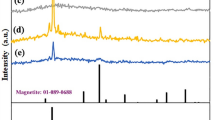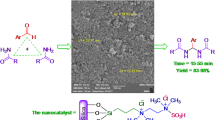Abstract
The thermal behavior of the anticancer drug-irinotecan was measured by Thermogravimetry–Differential thermal analysis (TG–DTA) to explore the application of TG–DTA in nanomedicine firstly. The TG–DTA result showed that the irinotecan was oxidized completely before 700 °C. When irinotecan was loaded onto nanosized mesoporous silica spheres, the loading capacity for irinotecan measured by TG–DTA was about 9.11% in the irinotecan/mesoporous SiO2 composite, similar to the typical UV–Vis spectra results (10.5%), which showed that TG–DTA characterization provided an alternative method to determine the drug loading amount on inorganic carriers. Secondly, Thermogravimetry–Differential scanning calorimetry–Mass Spectrometry coupling techniques (TG–DSC–MS) were used to characterize the hydrogen adsorption temperature and capacity of TiCr1.2 (V-Fe)0.6 alloy. The MS result showed that the released region of hydrogen was 250–500 °C, which was consistent with the TG–DSC results. Lastly, TA–MS combined with pulse thermal analysis (PulseTA) were used for a simultaneous characterizing study in the changes of mass, determination and quantitative calibration of the evolved nitrogen formed during the thermal decomposition of the InN powder. The results showed that relative error of this method between measured value and theoretical value was 2.67% for the quantitative calibration of evolved N2. It shows that TA–MS combined with PulseTA techniques offer a good tool for the quantification of the evolved nitrogen in the InN powder.






Similar content being viewed by others
References
Ozawa T. Thermal analysis-review and prospect. Thermochim Acta. 2000;355:35–42.
Dakka SM. TG/DTA/MS of poly (methyl methacrylate) the effect of particle size. J Therm Anal Calorim. 2003;74:729–34.
Vyazovkin S. Thermal Analysis. Anal Chem. 2004;76:3299–312.
Utschick H, Ritz M, Mallon HJ, Arnold M, Ludwing W, Kettrup A, Mattuschek G, Cyrys J. Investigations on the thermal degradation of post-chlorinated polyvinyl chloride. Thermochim Acta. 1994;234:139–51.
Lu CW, Wang Q, Chen YX, Shi JL. Simultaneous characterizing study of the metallic iron—organic coordination compounds by TG–DSC–MS coupling techniques. Thermochim Acta. 2003;404:63–70.
Jacab E, Till FST, Kozhabekov SS, Zhubanov BA. Thermal decomposition of aryl—alicyclic polyimides studied by thermogravimetry/mass spectrometry and pyrolysis—gas chromatography/mass spectrometry. J Anal Appl Pyrolysis. 1992;23:229–43.
Małecka B, Łacz A. Thermal decomposition of cadmium formate in inert and oxidative atmosphere. Thermochim Acta. 2008;479:12–6.
Liu YH, Zhao JZ, Zhang H, Zhu YC, Wang ZC. Thermal decomposition of basic zinc carbonate in nitrogen atmosphere. Thermochim Acta. 2004;414:121–3.
Madarasz J, Kaneko S, Okuya M, Pokol G. Comparative evolved gas analyses of crystalline and amorphous titanium(IV)oxo-hydroxo-acetylacetonates by TG–FTIR and TG/DTA–MS. Thermochim Acta. 2009;489:37–44.
Kooli F. Thermal stability investigation of organo-acid-activated clays by TG–MS and in situ XRD techniques. Thermochim Acta. 2009;486:71–6.
Lu CW, Xi TG. “Thermal Analysis-Mass Spectrometry”. China: Shanghai Science and Technology Reference Publishing House; 2002.
Zayed MA, Nour FA, Dien EL, Hawash MF, Fahmey MA. Mass spectra of gliclazide drug at various ion sources temperature its thermal behavior and molecular orbital calculations. J Therm Anal Calorim. 2010;101:1161–5.
Alcolea A, Ibarra I, Caparros A, Rodrıguez R. Study of the MS response by TG–MS in an acid mine drainage efflorescence. J Therm Anal Calorim. 2010;102:305–12.
Chen Y, Chen HR, Guo LM, He QJ, Chen F, Zhou J, Feng JW, Shi JW. Hollow/Rattle-type mesoporous nanostructures by a structural difference-based selective etching strategy. ACS Nano. 2010;4(1):529–39.
Zhu YF, Shi JL, Shen WH, Dong XP, Feng JW, Ruan ML, Li YS. Novel stimuli-responsive controlled drug release from a hollow mesoporous silica sphere/polyelectrolyte multilayers core-shell structure. Angew Chem Int Ed. 2005;44:5083–7.
Hsiao JK, Tsai CP, Chung TH, Hung Y, Yao M, Liu HM, Mou CY, Yang CS, Chen YC, Huang DM. Mesoporous silica nanoparticles as a delivery system of gadolinium for effective human stem cell tracking. Small. 2008;4(9):1445–52.
Lee CH, Cheng SH, Wang YJ, Chen YC, Chen NT, Souris J, Chen CT, Mou CY, Yang CS, Lo LW. Near-infrared mesoporous silica nanoparticles for optical imaging: characterization and in vivo biodistribution. Adv Funct Mater. 2009;19:215–22.
Zhao WR, Chen HR, Li YS, Li L, Lang MD, Shi JL. Uniform rattle-type hollow magnetic mesoporous spheres as drug delivery carriers and their sustained-release property. Adv Funct Mater. 2008;18:2780–8.
Maciejewski M, Emmerich WD, Baiker A. Pulse thermal analysis–a new range of opportunities. J Therm Anal Calorim. 1999;56:627–37.
Maciejewski M, Baiker A. Quantitative calibration of mass spectrometric signals measured in coupled TA–MS system. Thermochim Acta. 1997;295:95–105.
Maciejewski M, Muller CA, Tschan R, Emmerich WD, Baiker A. Novel pulse thermal analysis method and its potential for investigating gas-solid reactions. Thermochim Acta. 1997;295:167–82.
Eigenmann F, Maciejewski M, Baiker A. Gas adsorption studied by pulse thermal analysis. Thermochim Acta. 2000;359:131–41.
Li X, Zhang LX, Dong XP, Liang J, Shi JL. Preparation of mesoporous calcium doped silica spheres with narrow size dispersion and their drug loading and degradation behavior. Microporous Mesoporous Mater. 2007;102:151–8.
Zhu YF, Shi JL, Li YS, Chen HR, Shen WH, Dong XP. Storage and release of ibuprofen drug molecules in hollow mesoporous silica spheres with modified pore surface. Microporous Mesoporous Mater. 2005;85(1–2):75–81.
Gao L, Zhang QH, Li JG. Preparation of ultrafine InN powder by the nitradation of In2O3 or In(OH)3 and its thermal stability. J Mater Chem. 2003;13:154–8.
Acknowledgements
The authors greatly acknowledge the financial supports from National Nature Science Foundation of China (no. 21005083) and National Key Technology R & D Program (no. 2006BAA04B02-01).
Author information
Authors and Affiliations
Corresponding author
Rights and permissions
About this article
Cite this article
Huimei, Y., Lingjun, Q., Qinghong, Z. et al. Application of TA–MS combined with PulseTA for characterization of materials. J Therm Anal Calorim 106, 47–52 (2011). https://doi.org/10.1007/s10973-010-1280-0
Published:
Issue Date:
DOI: https://doi.org/10.1007/s10973-010-1280-0




